Efficient computation method for electromagnetic modeling
a computation method and electromagnetic modeling technology, applied in the field of geophysical prospecting, can solve the problems of losing the advantages of the frequency domain method in time domain analysis in the deep water case, the computational task of simulation of electromagnetic fields is very demanding, and the cost of csem is computationally even more expensive than the frequency domain method
- Summary
- Abstract
- Description
- Claims
- Application Information
AI Technical Summary
Benefits of technology
Problems solved by technology
Method used
Image
Examples
case p (
[0077]FIG. 4 shows results for stations at the 0, 5, and 10 km positions for antennas with vertical orientation. The data for the 5-km station are taken from the reciprocal experiment, so that the field values for the primary and reciprocal surveys should again be equal at the 2.5 km and at the 7.5 km positions (again indicated by vertical arrows). Three sets of curves are plotted over each other in this figure, representing results from different mesh interpolation techniques. The inset magnification 41 around one of the expected reciprocal points (˜7.5 km) shows varying degrees of success in honoring the Reciprocity Principle; again, numerical results are presented in the tables below. The three cases having deviations from reciprocal behavior shown with double-headed arrows labeled O, L, and P are described as follows:[0078]Case O (“original”) uses the original mesh, with coarse uniform spacing in the X and Y directions. This case (with the two bold dashed curves) has the largest...
PUM
 Login to View More
Login to View More Abstract
Description
Claims
Application Information
 Login to View More
Login to View More - R&D
- Intellectual Property
- Life Sciences
- Materials
- Tech Scout
- Unparalleled Data Quality
- Higher Quality Content
- 60% Fewer Hallucinations
Browse by: Latest US Patents, China's latest patents, Technical Efficacy Thesaurus, Application Domain, Technology Topic, Popular Technical Reports.
© 2025 PatSnap. All rights reserved.Legal|Privacy policy|Modern Slavery Act Transparency Statement|Sitemap|About US| Contact US: help@patsnap.com



